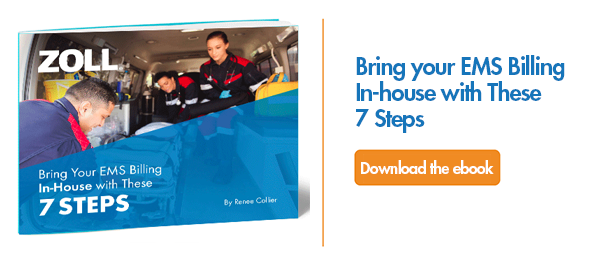Chart Smarter: Why One EMS Agency Ditched Paper for Mobile Tech
Is it more cost effective to outsource your EMS billing or do it in-house?

A question many small and medium providers face – should we outsource our billing or is in-house billing better?
Providers need to do a combination of soul-searching and concrete analysis. Below we discuss the benefits of in-house billing and outsourced billing, the costs involved, the personnel issues, and the things to consider before making a choice. There are pros to BOTH solutions.
Let’s start with the decision-making process. Some providers feel that trip volume has an impact on their decision. Small or medium services may believe they don’t have the resources to apply to billing. That is not necessarily true. Good documentation backed by quality billing software and trained personnel can lead to effective billing and good cash flow.
I recommend providers think realistically about what can be accomplished. Most billing effort is expended on claims creation but, claims rejections and denials may need more time per trip to resolve than what was expended on the original claim. This is an area where we as organizations struggle – it takes so much time to get claims OUT the door that there may be little time left to address claims that walked back IN without payment. That’s a big question – does the in-house team have the time and resources to file claims, follow-up, and pursue denials? If the answer is “no,” it might be best to have an outsourced solution with the resources to handle these issues.
There are many costs involved in the process of billing. Recruiting and training personnel presents a big challenge for providers. There are not enough quality people local to every provider to staff billing departments. Ongoing periodic training to maintain compliance is needed as well as routine audits. There is a cost to maintain technology, including the purchase of hardware and software and its updates. There is also the cost of staffing and the associated payment of taxes and benefits. Office supplies are needed for claim processing (which includes cost of paper, toner, postage, envelopes, and more). Last but not least, there are collection costs.
There are reports that say that outsourcing could cut 30% to 40% of billing costs. But, if the organization has already invested in hardware, software, and billing training, those lost costs get factored into the decision equation. Even if outsourced, there are costs that remain within an organization – there must be a good QA program and someone to review documentation prior to sending it to the billing company; crews need periodic training to maintain compliance (but the billing company can be a big help here). Additionally, there are costs of technology to maintain a patient care reporting system and potential collection costs.
Look at the costs involved in billing. If incremental cost savings are less than incremental costs, consider in-house billing. If incremental cost savings equal incremental costs, qualitative factors must be used to make the decision (community impact, staff impact, etc.).
If incremental cost savings are greater than incremental costs, then outsource billing. How do you determine those incremental costs? Look at trip volume and determine billing costs to bill total trip volume. Next, calculate total cost to bill one more trip. Incremental cost is determined by taking the total costs of your current volume minus the total costs with the additional trip.
Regardless of cost, there are intangible issues that could affect the service and/or community. What about employee morale, goodwill in the community, the feasibility of implementing an outsourced billing solution and the availability of resources? What will happen to current billing staff? Can they be absorbed elsewhere in the organization or will they be laid off? What about the office space currently used to perform billing?
There are many benefits to outsourcing. Billing services usually have scale to purchase and deploy technologies required to submit claims, battle insurance companies, and collect self-pay balances. They commit dedicated staff to denials and appeals. They are able to attract high caliber staff and retain them because they provide opportunities for staff growth and advancement.
Billing companies have a broad view of the industry. They deal with more providers, more facilities and more payers. As a result, they are able to recognize patterns and trends among the payers. I routinely hear of billing companies who go to battle with the VA or visit the offices of an insurer or a local Medicare contractor to resolve problems. Billing companies have might. They have knowledge and they have volume on their side to support their efforts. They have resources to be the “squeaky wheel that gets greased.”
On the other hand, in-house billers sometimes feel they have a “stake” in the outcome of a claim; they know the crew members who cared for the patient. They may even know the patient in person. They know the unique elements of the service – demographics, community, the geography of the area. As a result, they fight hard to resolve issues.
Providers feel that in-house billing gives them control and visibility into how accounts are worked, and that in-house billing allows the provider to be nimble and move resources quickly to respond to problems. However, this only works if you have the staff resources available. There is a concern among providers that outsourcing may alienate patients or facilities. There is also a concern that billing services will only go after the low-hanging fruit and leave the more difficult money uncollected.
Insourcing has advantages, one of the most important being improved bi-directional communication – with billing and field providers, with billing and dispatch, and with billing and the patients and community at large.
What about fees? Yes, outsourced billing comes with fees (typically a per trip fee or a percentage of collection). But outsourced billing may improve the rate of net collections because more dedicated resources are committed to billing and follow-up activities.
Compliance is essential whether billing is done in-house or outsourced. It is the provider’s name and number on the claim – that means that even if billing is outsourced, the provider is responsible.
Therefore, ask good questions if outsourcing is the choice, like:
- How long has company done ambulance billing?
- Is staff certified? CPC? CAC? What is their experience?
- What memberships or affiliations with local, state, or national associations?
- Name and frequency of reports
- Who owns billing data? Do we get it back if contract ends?
- Will billing company provide training? For billing coordination? For field providers? How often?
- HIPAA Compliance Officer/Committee? Who?
- References
- Cost – what is included and what is NOT included
- Process – how often statements, phone calls, reports
Related Posts
The End of Delayed Documentation
4 Must-have Data Points for Dispatch-Billing Alignment and Maximum Reimbursement
ZOLL Pulse Blog
Subscribe to our blog and receive quality content that makes your job as an EMS & fire, hospital, or AR professional easier.
ZOLL Pulse Blog
Subscribe to our blog and receive quality content that makes your job as an EMS, fire, hospital, or AR professional easier.







